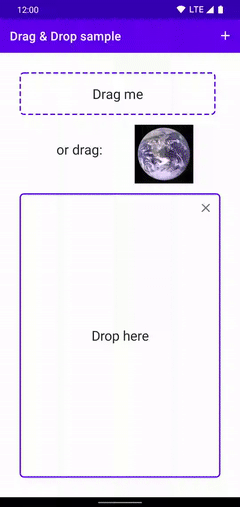Platforma przeciągania i upuszczania na Androidzie umożliwia dodawanie do aplikacji funkcji przeciągania i upuszczania. Dzięki niej użytkownicy mogą kopiować i przenosić tekst, obrazy, obiekty i inne treści, które mogą być reprezentowane przez identyfikator URI, z View do drugiego w aplikacji lub między aplikacjami w trybie wielu okien.

|

|
|
|
|
Platforma zawiera klasę zdarzeń przeciągania, detektory zdarzeń przeciągania oraz klasy pomocnicze. Platforma ma służyć przede wszystkim do przenoszenia danych, ale można jej używać też do innych działań w interfejsie. Na przykład możesz utworzyć aplikację, która łączy kolory, gdy użytkownik przeciąga ikonę koloru na inną ikonę. W pozostałej części dokumentu opisujemy, jak działa metoda „przeciągnij i upuść” w kontekście przenoszenia danych.
Przegląd
Proces przeciągania obejmuje kilka elementów.
Przeciąganie źródła: widok punktu początkowego procesu przeciągania i upuszczania.
Element docelowy: widok, w którym można akceptować dane przeciągania.
Przeciągany cień: cień do przeciągania reprezentuje przeciągane dane i jest widoczny dla użytkowników.
Zdarzenia przeciągania: gdy użytkownik przesuwa cień nad układem aplikacji, system wysyła zdarzenia przeciągania do detektorów zdarzeń przeciągania i metod wywołania zwrotnego powiązanych z obiektami
Vieww układzie.
Operacja przeciągania i upuszczania rozpoczyna się, gdy użytkownik wykonuje gest interfejsu rozpoznawany przez aplikację jako sygnał do rozpoczęcia przeciągania danych. W odpowiedzi aplikacja powiadamia system, że rozpoczyna się operacja przeciągania i upuszczania. System wywołuje Twoją aplikację, aby uzyskać cień do przeciągania i pokazać go użytkownikom podczas przeciągania i upuszczania.
Gdy użytkownik przesuwa cień nad układem aplikacji, system wysyła zdarzenia przeciągania do detektorów zdarzeń przeciągania i metod wywołania zwrotnego powiązanych z obiektami View w układzie. Jeśli użytkownik zwolni cień na obszar docelowy, system wyśle do niego dane. Przeciąganie i upuszczanie kończy się, gdy użytkownik zwolni cień, niezależnie od tego, czy cień znajdzie się nad elementem docelowym.
Tematy
- Najważniejsze pojęcia
- Zapoznaj się z procesem przeciągania i upuszczania.
- DropHelper ułatwiający przeciąganie i upuszczanie
- Dowiedz się, jak stosować przeciąganie i upuszczanie w narzędziu
DropHelper. - Wdrażanie funkcji przeciągania i upuszczania w widokach
- Możesz też zastosować przeciąganie i upuszczanie w widokach Androida, co daje deweloperom większą kontrolę nad szczegółami.
- Przeciąganie i upuszczanie w trybie wielu okien
- Obsługuje przeciąganie i upuszczanie w trybie wielu okien oraz umożliwia przenoszenie obiektów między różnymi aplikacjami.
Dodatkowe materiały
- Ćwiczenie z programowania dotyczące przeciągania i upuszczania przy użyciu widoków
- Przeciągnij i upuść, aby płynnie wykonywać wiele zadań jednocześnie
- Przeciągnij i upuść Sample zawierającą różne sposoby przeciągania i upuszczania oraz obsługi multimediów.


